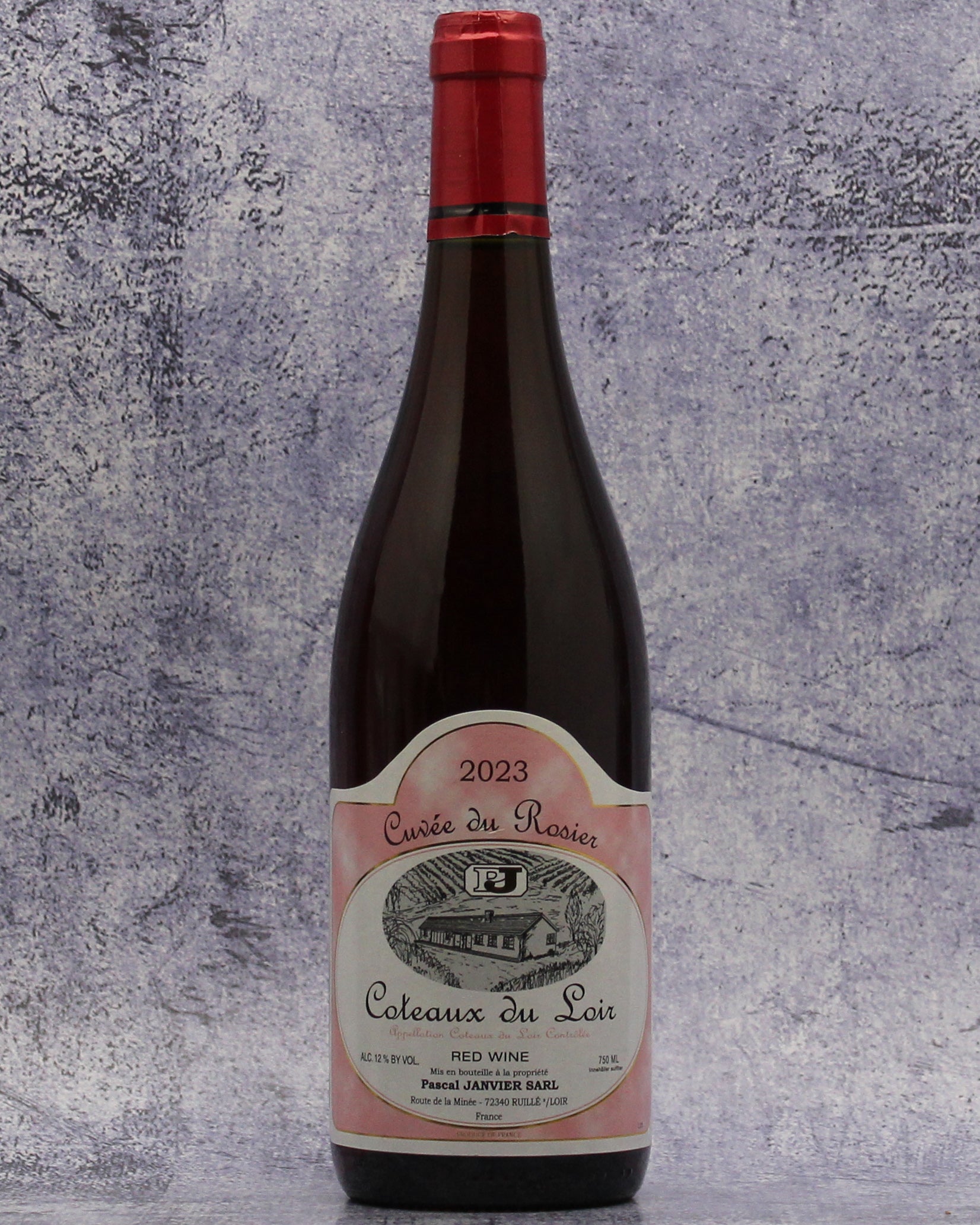Description
From: Loire Valley, France
Varietal: Pineau d’Aunis
Taste: “In the glass, his Cuvée du Rosier looks (and often drinks) like young Pinot Noir. Its bright strawberry and sour cherry notes lead into a spicy finish recalling cracked pepper. Juicy and lively thanks to a palate-tickling hint of effervescence, it is best served slightly chilled, as you would a Beaujolais, and can be paired with anything (or nothing at all), but goes especially well with tricky-to-pair dishes that have a kick. This wine is truly a knockout with spicy food, and the KLWM staff delights in swapping stories of matchmaking it with the plethora of takeout options we have in and around the Bay Area. From zesty curries to kimchi bibimbap, a chilled glass of this hidden gem cuvée will refresh a sizzling palate like a cooling elixir, while at the same time enhancing all the flavors at table.”
—Madison Brown
Pairing: With a “light, bright and savory” essence that shows off a vibrant, crunchy red fruit and rose petal vibe under a veil of peppercorn and calling for a chill, this Pineau d’Aunis is going to be a star on the table. We love enjoying wine like this there’s a ton of food on the table because its characteristics (fresh flavors calling for a slight chill, bright fruit, a savory side, and light-bodied with very little tannins) mean that it’ll pair excellently with a wide assortment of flavors and foods without leaving you feeling heavy. A few examples include serving it alongside dishes like French-style chicken in vinegar with peppered polenta, roasted chicken or turkey with stuffing, gravy, potatoes, cranberry, and green beans, Swedish meatballs with lingonberry sauce, potatoes and gravy, Thai-style beef salad with chilies (most Thai cuisine pairs well with this wine), seared duck ramen, chow fun, Sweet & Sour Chicken or Pork, Dan Dan Noodles, Sweet & Sour Eggplant with Garlic Chips, Chinese Roast Pork, Char Siu, BBQ Spareribs, and even pork won ton dumplings or a classic snacking favorite, Chicken-Liver Mousse (shown below).
Chicken-Liver Mousse
Recipe from Marlow & Sons
Adapted by Pete Wells
About. Many thanks to importer Kermit Lynch Wine Merchants for the following information. Pascal Janvier never planned on becoming a vigneron. Though his parents had vineyard land of their own, they did not make their own wine. Instead, he went to school to learn butchery. However, Pascal made a sudden about-face at the age of thirty and decided to study winegrowing in Amboise. His serious and soft-spoken demeanor reflects a man prone to quiet contemplation and great deliberation. His decision was anything but a whim. Starting slowly, he has mastered his craft with a focus and passion that is contributing towards the revival of the small appellation of Jasnières, in the department of the Sarthe in the Val du Loir. The Loir is a tributary of the Loire River, and its viticultural area is the most northerly (and coldest) of the greater Loire region. The once proud appellations of Jasnières and the Coteaux du Loir (the preferred wines of King Henri IV) are now all but extinct, with still less than one hundred and two hundred hectares still respectively under vine. Pascal, with the help of his wife Dominique, is doing his part to remind everyone what Jasnières is capable of.
The Janviers rent sixty-six different parcels (a total of nine hectares) of land and farm it entirely themselves. Jasnières produces some of the best dry Chenin Blanc (Pineau de la Loire) in the world, and its wines are said to reach their peak ten years after the vintage. The soils of their parcels are comprised of clay, limestone, sand and silex (flint), and are planted primarily to Chenin Blanc. KLWM imports one bottling of their red, made from the lighter-bodied and elegant indigenous red grape, Pineau d’Aunis. Their “Cuvée du Silex” parcel has distinct flint in the soil, lending notes of gunpowder to this beautiful, crisp Chenin. There is no doubt that Pascal and Dominique have chosen the path less traveled, though at the first sip of their wine, one understands why they keep working so hard. Their stunning aromatics and complexity prove them to be one of the greatest values in the KLWM Loire Valley Portfolio, along with the celebrated wines of Château d’Epiré. If over-alcoholic wines are getting to you, Pascal Janvier’s wines are a great refuge.
About the region. Coteaux du Loir is a small appellation title for red, white and rosé wines from 22 communes in a rather obscure viticultural area just to the north of the Touraine region. As such it is classified as part of the Loire Valley group of appellations, while not lying in the valley itself.
There are only around 70 hectares of vineyards. These follow the course of the Loir river, after which the title is named. This should not be confused with the larger, more famous Loire. The latter lies 35 kilometers (20 miles) to the south.
While Coteaux du Loir white wines account for 35 to 40 percent of total output, they are of greatest interest to wine enthusiasts. They vary from bone dry and steely to incredibly sweet, honey scented botrytized wines. Styles depend both on the winemaker and the conditions of the growing season.
Made exclusively from Chenin Blanc, the Coteaux du Loir whites bear a passing resemblance to Savennières and dry Vouvray. However they often lack the richness and finesse of these better-known wines.
The whites of the adjacent Jasnières region stand up more favorably to this comparison. They come from the better exposed vineyards in the communes of Lhomme and Ruillé-sur-Loir.
Red wines make up about 45 percent of the appellation's output. They are produced from Gamay, Pineau d'Aunis, Malbec and 'Cabernet' – a blend of Franc and Sauvignon. They are fruit driven wines, light in body and relatively high in acidity – a trademark of almost all Loire reds.
Rosés account for just under 20 percent of Coteaux du Loir wines. They are made from the same varieties as those listed above, with an additional component of Grolleau Noir – the grape historically responsible for so many sweet Loire rosés. Grolleau is being phased out across the Loire and is limited to 25 percent of a blend under the Coteaux du Loir appellation laws.
As in Saumur to the southwest, Coteaux du Loir wines are made from vineyard sites rich in tuffeau. This is the sedimentary limestone laid down 90 million years ago in the Turonian Age, when the whole Loire Valley lay under the ocean.
This wine. Vigneron by way of butcher, Pascal Janvier is one of those souls destined to make wine, despite himself. Fortunately, he wised up at age thirty and yielded to his inevitable fate. Today, Pascal and his wife Dominique farm a total of nine hectares in the department of the Sarthe in the Val du Loir, a tiny, stony hillside along the Loir River (a tributary of the Loire River), north of Vouvray that is also the most northerly - and coldest - of the regions of the Loire. The "Cuvée du Rosier" is 100% Pineau d'Aunis from 25-year-old vines planted to 1.6 ha of sandy clay soils in order to promote the development of richness and depth in the fruit. This indigenous red variety yields naturally light-bodied, fragrant reds, with youthful red berry aromas and flavors accented by mineral and herbal notes. Its low to moderate alcohol content, bright acidity, and distinctive herbal qualities make it best enjoyed with food - assorted meats, truffle-infused dishes, and aged goat cheese in particular.
One of the Loire’s rarest red grapes, Pineau d’Aunis is downright obscure compared to the region’s golden child, Cabernet Franc. As with many of France’s grape varieties, Pineau d’Aunis was nearly wiped out by phylloxera in the 1860s. A notoriously finicky grape, it was widely replaced with easier-to-grow, higher-yielding varieties. Pineau d’Aunis acreage had been in steady decline until around twenty years ago when local vignerons, fearing its impending extinction, began an effort to put the indigenous variety back on the map. Only about a thousand acres are planted to Pineau d’Aunis in France today. In the Coteaux du Loir appellation, Pascal Janvier dutifully tends his vines to craft a 100% Pineau d’Aunis cuvée—the only bottling of this extraordinary grape in our entire portfolio.

